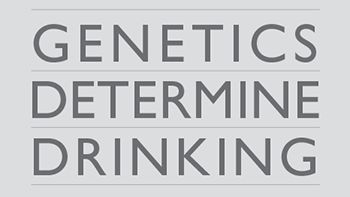GENETICS DETERMINE DRINKING
HOW MUCH ONE DRINKS
is strongly influenced by
whether the drinking
is reinforced by
pleasurable sensations
or punished by torment.
The outcome is
largely decided
by inheritance.
Key aspects of drinking are how the body – especially the brain – metabolizes, degrades, neutralizes alcohol, and whether the process rewards or punishes the drinker. Genetic variability plays a large role, as do quantity and rate of ingestion, the time of the last meal, sex and size, and drinking experience of the drinker. Pleasure and pain resulting from drinking may be genetically determined, in turn influencing whether one becomes dependent on alcohol, averse or, as for most of us, can take it or leave it to consume in appropriate circumstance and quantity for enjoyment and health. As a member of the International Scientific Forum on Alcohol Research (bu.edu/alcohol-forum), I recently had the opportunity to review “Gene Specific Modifications Unravel Ethanol and Acetaldehyde Actions”, by Y. Israel, M. Rivera-Meza, E. Karhanian, et al., an interesting and well-written scientific review from the University of Chile and Diego Portales University, Santiago, which has been accepted for publication in frontiers in behavioral neuroscience (2O13;7:8O).
Not being a lover of technical intricacies, I shall try to make the biochemistry as painless as possible. Imbibed alcohol starts its neutralization in the stomach and upper small intestine, but the major action is in the liver, where the enzyme alcohol dehydrogenase facilitates the conversion to acetaldehyde – a thoroughly noxious compound. Fortunately, in most circumstances the acetaldehyde is rapidly converted to harmless acetate by the action of acetaldehyde dehydrogenase, and thence to carbon dioxide and water. Other tissues, including the linings of blood vessels, also express aldehyde dehydrogenase activity.
The brain, however, is different. Acetaldehyde does not, except when in unusually high concentration, penetrate into brain tissue: it is blocked by the blood-brain barrier. But the compound is generated within the brain substance, which lacks alcohol dehydrogenase, by the actions of catalase and cytochrome enzymes upon alcohol.
The effects of alcohol, beneficial and adverse, are familiar and amply documented. Those of acetaldehyde, alcohol’s first breakdown product, are less well known to the unaffected: anxiety, flushing, rapid heart rate, headache, nausea and vomiting, and a fall in blood pressure. There is suspicion that over the long term acetaldehyde may be a carcinogen. Acetaldehyde concentration may become elevated via either of two genetically determined pathways: a hyperactive alcohol dehydrogenase in the liver generating an abnormally large quantity, or an inactive form of acetaldehyde dehydrogenase allowing the accumulation of acetaldehyde. Up to 4O percent of individuals of east Asian origin (China, Japan, Korea) are so afflicted. As observed in this population and in similarly affected laboratory rats, the effects of elevated acetaldehyde lead to aversion to alcohol. The drug disulfiram (Antabuse), used to treat alcoholism, works on the same basis – inhibiting aldehyde dehydrogenase from eliminating acetaldehyde.
Strangely, as discovered in the ever-accommodating rats, when acetaldehyde is generated within the brain in contrast to the rest of the body, rather than rendering ingestion of more alcohol as unpleasant, it amplifies the pleasurable effects of drinking, leading to more – even to binging. Inhibition of formation of acetaldehyde in the brain reduces drinking.
The so-far incomplete understanding of this counterintuitive dichotomy may hold important implications in the prevention and treatment of alcoholism.

